Ion trap mass spectromter
a mass spectrometer and ion trap technology, applied in mass spectrometers, separation processes, stability-of-path spectrometers, etc., can solve the problems of increasing analysis cost, reducing analysis throughput, and elongating the measurement time to obtain a measurement result, so as to improve analysis throughput, the effect of reducing the measurement time required for the creation of a mass spectrum with a comparable s/n and increasing signal intensity
- Summary
- Abstract
- Description
- Claims
- Application Information
AI Technical Summary
Benefits of technology
Problems solved by technology
Method used
Image
Examples
embodiments
First Embodiment
[0097]The configuration and operation of the matrix assisted laser desorption ionization digital ion trap mass spectrometer (MALDI-DIT-MS) which is an embodiment (the first embodiment) of the present invention will be described in detail. FIG. 1 is an entire configuration diagram of the MALDI-DIT-MS according to this embodiment.
[0098]The ion trap 20 is the previously-described three-dimensional quadrupole ion trap which is composed of a circular ring electrode 21 and a pair of end cap electrodes 22 and 23 opposing (high and low in FIG. 1) each other with the ring electrode 21 therebetween. An ion inlet 25 is bored through the substantially center of an entrance-side end cap electrode 22. Outside of the ion inlet 25, an entrance-side electric field correction electrode 27 is placed for correcting the disorder of the electric field around the ion inlet 25. At substantially center of the exit-side end cap electrode 23, an ion outlet 26 is bored substantially in alignmen...
second embodiment
[0126]Next, as another embodiment (the second embodiment) of the present invention, a MALDI-DIT-MS, in which the function of the additional ion injection into the ion trap as previously described is used for a mass calibration, will be described. Generally, in order to obtain data with high mass accuracy in a mass spectrometer, it is inevitable to perform a mass calibration using a standard sample whose mass-to-charge ratio is known. A mass calibration in a conventional MALDI-IT-MS is performed in the same manner as an apparatus without an ion trap such as a MALDI-TOFMS. Generally, there are two methods for performing a mass calibration in a MALDI-TOFMS: the external standard method and the internal standard method.
[0127]In performing a mass calibration by the external standard method, before a measurement of an analysis sample (analyte), an analysis operator applies a calibration sample (calibrant) including a compound whose mass-to-charge ratio is known at a different position on ...
PUM
 Login to View More
Login to View More Abstract
Description
Claims
Application Information
 Login to View More
Login to View More - R&D
- Intellectual Property
- Life Sciences
- Materials
- Tech Scout
- Unparalleled Data Quality
- Higher Quality Content
- 60% Fewer Hallucinations
Browse by: Latest US Patents, China's latest patents, Technical Efficacy Thesaurus, Application Domain, Technology Topic, Popular Technical Reports.
© 2025 PatSnap. All rights reserved.Legal|Privacy policy|Modern Slavery Act Transparency Statement|Sitemap|About US| Contact US: help@patsnap.com



